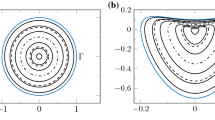Summary
Numerical solutions of boundary value problems for elliptic equations with discontinuous coefficients are of special interest. In the case when the interface (i.e. the surface of the discontinuity of the coefficients) is smooth enough, then also the solution is usually very smooth (except on the interface). To obtain a high order of accuracy presents some difficulty, especially if the interface does not fit with the elements (in the finite element method). In this case the norm of the error in the spaceW1/2 is of the orderh 1/2 (see e.g. [1]) and on one dimensional case it is easy to see that the accuracy cannot be improved. In this paper we shall show an approach which avoids this difficulty. The idea is similar to [2]. We shall show the proposed approach on a model problem — theDirichlet problem with an interface forLaplace equation; this will avoid pure technical difficulties. The boundary of the domain and the interface will be assumed smooth enough. The sufficient condition for the smoothnees can be determined.
Zusammenfassung
Numerische Lösungen von Randwertproblemen elliptischer Gleichungen mit diskontinuierlichen Koeffizienten sind von besonderem Interesse. In jenem Fall, wo die „Sprungfläche” (d. h. die Fläche der Sprungstelle der Koeffizienten) genügend glatt ist, ist auch die Lösung normalerweise glatt (außer auf der „Sprungfläche” selbst). Es bereitet einige Schwierigkeiten, einen hohen Grad von Genauigkeit zu erzielen, speziell, wenn die „Sprungstelle” nicht mit den Elementen zusammenfällt (in der Methode der finiten Elemente). In diesem Fall liegt die Norm des Fehlers in dem RaumW1/2 in der Größenordnung vonh 1/2 (siehe z. B. [1]) und im eindimensionalen Fall kann man leicht erkennen, daß die Genauigkeit nicht verbessert werden kann. In dieser Arbeit wird ein Weg (ähnlich [2]) gezeigt, welcher diese Schwierigkeit vermeidet. Der vorgeschlagene Weg wird an einem Modellfall erläutert — dasDirichlet-Problem mit einer Sprungfläche für dieLaplace-Gleichung; dadurch werden rein technische Schwierigkeiten vermieden. Die Randfläche und die „Sprungfläche” werden glatt genug angenommen. Eine hinreichende Bedingung für die Glattheit kann angegeben werden.
Similar content being viewed by others

References
Rivkind, V. Ja.: On an estimate of the rapidity of convergence of homogenous difference schemes for elliptical and parabolic equations with discontinuous coefficients (Russian). Problems Math. Anal., Boundary Value Problems, Integr. Equations (Russian), pp. 110–119, Izd. Leningr. Univ. Leningrad. 1966.
Babuška, I.: Numerical solution of boundary value problems by perturbed variational principle. Technical note BN-624, Univ. of Maryland, The Inst. for Fluid. Dyn. and Appl. Math. 1969.
Lions, J. L., andE. Magenes: Problèmes aux limits non homogènes et applications. V.I. Paris: Dunod. 1968.
Babuška, I.: Approximation by hill functions. Technical note BN-648, Univ. of Maryland, The Inst. for Fluid. Dyn. and Appl. Math. 1970.
Šefteł, Z. G.: A general theory of boundary value problems for elliptic systems with discontinuous coefficients (Russian), Ukrain. Math. Ž.18, 132–136 (1966).
Šefteł, Z. G.: Energy inequalities and general boundary problems for elliptic equations with discontinuous coefficients (Russian). Sibirsk Math. Ž.6, 636–668 (1965).
Šefteł, Z. G.: The solution inL p and the classical solution of general boundary value problems for elliptical equations with discontinuous coefficients (Russian). Uspechi Math. Nauk19, 230–232 (1964).
Author information
Authors and Affiliations
Additional information
Dedicated to Professor Dr.L. Collatz on the occasion of his 60th birthday
This work was supported in part by National Science Foundation Grant NSF-GP 7844.
Rights and permissions
About this article
Cite this article
Babuška, I. The finite element method for elliptic equations with discontinuous coefficients. Computing 5, 207–213 (1970). https://doi.org/10.1007/BF02248021
Received:
Issue Date:
DOI: https://doi.org/10.1007/BF02248021



